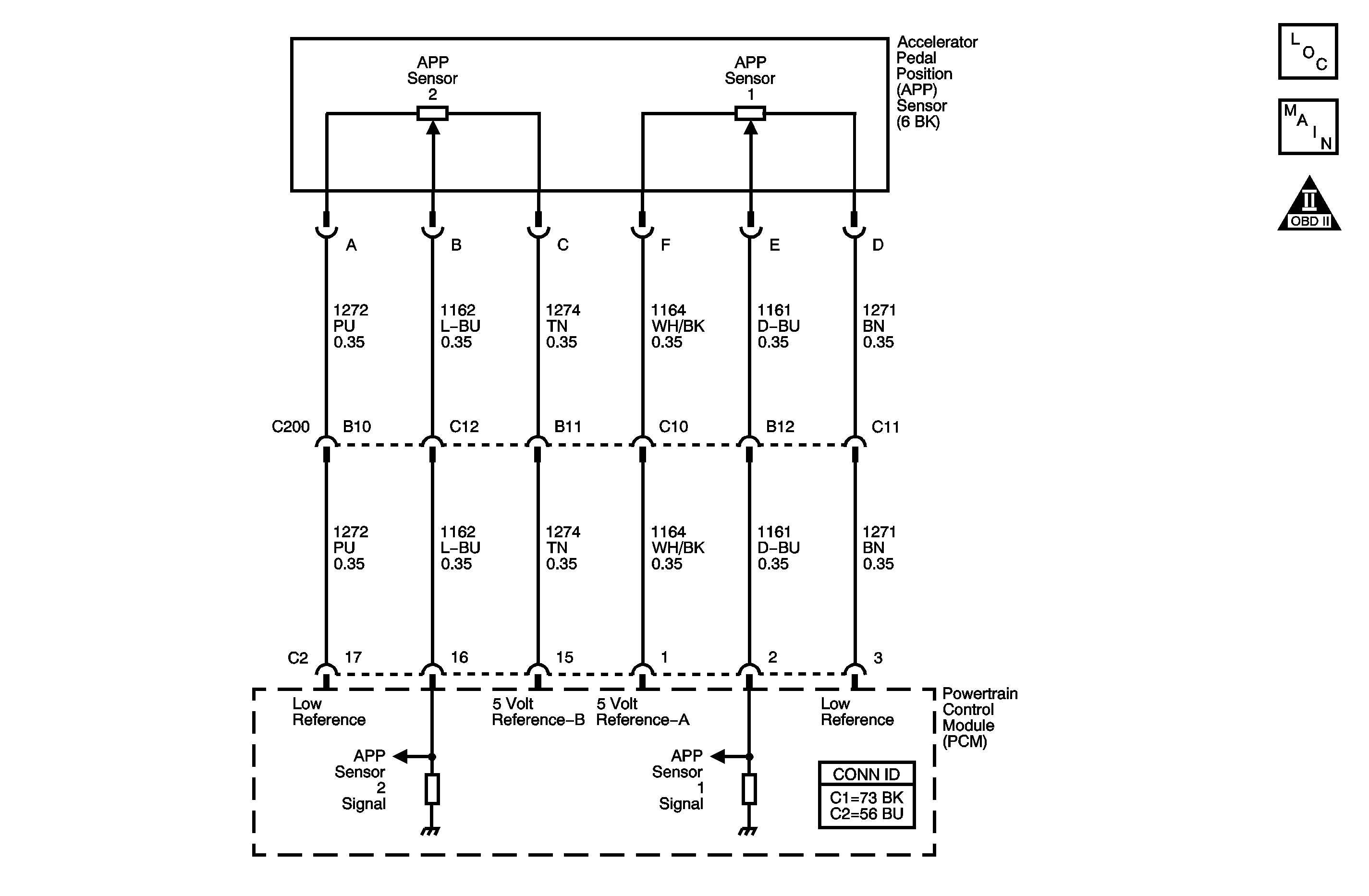
Circuit Description
The accelerator pedal assembly contains two accelerator pedal position (APP) sensors. The APP sensors are mounted in the pedal assembly and are not serviceable. The APP sensors provide a signal voltage that changes relative to the position of the accelerator pedal. The powertrain control module (PCM) supplies a separate 5-volt reference and low reference circuit for each of the APP sensors.
The APP sensor 1 signal voltage increases as the pedal is depressed, from approximately 1.0 volt at rest to above 4 volts when fully depressed. The APP sensor 2 signal voltage increases as the pedal is depressed, from approximately 0.5 volts at rest to more than 2 volts with the accelerator pedal fully depressed.
If the PCM detects that the APP sensor 1 signal voltage is too low, this DTC sets.
DTC Descriptor
This diagnostic procedure supports the following DTC.
DTC P2122 Accelerator Pedal Position (APP) Sensor 1 Circuit Low Voltage
Conditions for Running the DTC
| • | The ignition is ON. |
| • | DTC P2122 runs continuously. |
Conditions for Setting the DTC
The APP sensor 1 voltage is less than 0.20 volts for less than 1 second.
Action Taken When the DTC Sets
| • | The control module illuminates the malfunction indicator lamp (MIL) when the diagnostic runs and fails. |
| • | The control module records the operating conditions at the time the diagnostic fails. The control module stores this information in the Freeze Frame/Failure Records. |
Conditions for Clearing the MIL/DTC
| • | The control module turns OFF the malfunction indicator lamp (MIL) after 3 consecutive ignition cycles that the diagnostic runs and does not fail. |
| • | A current DTC, Last Test Failed, clears when the diagnostic runs and passes. |
| • | A history DTC clears after 40 consecutive warm-up cycles, if no failures are reported by this or any other emission related diagnostic. |
| • | Clear the MIL and the DTC with a scan tool. |
Test Description
The number below refers to the step number on the diagnostic table.
-
This step tests signal and 5-volt reference circuits.
-
After replacing the PCM, a new minimum throttle position and idle speed must be established.
Step | Action | Values | Yes | No | ||||
|---|---|---|---|---|---|---|---|---|
Connector End View Reference: Powertrain Control Module Connector End Views or Engine Controls Connector End Views | ||||||||
1 | Did you perform the Diagnostic System Check-Engine Controls? | -- | Go to Step 2 | |||||
2 | Is DTC P0641 also set? | -- | Go to DTC P0641 | Go to Step 3 | ||||
3 |
Is the APP sensor 1 parameter less than the specified value? | 0.15 V | Go to Step 5 | Go to Step 4 | ||||
4 |
Did the DTC fail this ignition? | -- | Go to Step 5 | Go to Intermittent Conditions | ||||
Is the APP sensor 1 voltage within the specified range? | 4.8-5.2 V | Go to Step 9 | Go to Step 6 | |||||
6 | Connect a DMM between the 5-volt reference circuit of the APP sensor 1 and a good ground. Is the measured voltage within the specified range? | 4.8-5.2 V | Go to Step 7 | Go to Step 8 | ||||
7 | Test the APP sensor 1 signal circuit for the following conditions:
Refer to Circuit Testing and Wiring Repairs in Wiring Systems. Did you find and correct the condition? | -- | Go to Step 13 | Go to Step 10 | ||||
8 |
Did you find and correct the condition? | -- | Go to Step 13 | Go to Step 10 | ||||
9 | Test for an intermittent and for a poor connection at the APP sensor 1. Refer to Testing for Intermittent Conditions and Poor Connections Connector Repairs and in Wiring Systems. Did you find and correct the condition? | -- | Go to Step 13 | Go to Step 11 | ||||
10 | Test for an intermittent and for a poor connection at the PCM. Refer to Testing for Intermittent Conditions and Poor Connections and Connector Repairs in Wiring Systems. Did you find and correct the condition? | -- | Go to Step 13 | Go to Step 12 | ||||
11 | Replace the APP sensor 1. Refer to Accelerator Pedal Position Sensor Replacement . Did you complete the replacement? | -- | Go to Step 13 | -- | ||||
Did you complete the replacement? | -- | Go to Step 13 | -- | |||||
13 |
Did the DTC fail this ignition? | -- | Go to Step 2 | Go to Step 14 | ||||
14 | Observe the Capture Info with a scan tool. Are there any DTCs that have not been diagnosed? | -- | System OK | |||||
